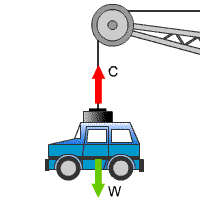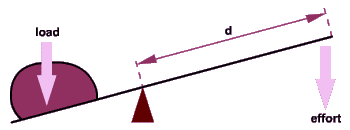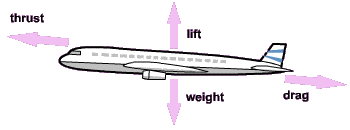|
Forces
What you should know.
- Forces are pushes and pulls. They can
change the size or shape of an object, change the speed of an object, change
the direction of a moving object.
- Forces are measured by Force-meters (also
called Newton Meters or spring balances).
- The size of a force is measured in
Newtons (N)
- When two objects rub together, friction
will slow them down.
- Air resistance can be reduced by
streamlining.
- Weight is a force. It is the pull of
gravity by the Earth.
- When an object is put in water, the water
pushes up on it. This force is called upthrust.
- When an object floats, the upthrust is
equal to the weight of the object. The two forces are balanced.
- Sea-water is more dense than fresh water
so a boat floats higher in sea-water.
- Levers and pulleys are simple machines. A
long spanner is easier to turn than a short spanner.
- A lever or pulley is used to lift a load
when you apply an effort force.
- A lever can be a force-magnifier (like a
spanner) or a distance-magnifier (like the arm).
- To start (or stop) a heavy object moving
needs a big force.
- Forces are shown in diagrams by arrows,
the bigger the force, the longer the arrow.
- An object can have more than one force
acting on it. If the forces are not balanced there is a resultant force.
It is the resultant force that makes the object move.
- Newtons Law: If the forces on an object
are balanced then if it is at rest, then it stays at rest. If it is moving
it keeps moving at a steady speed in a straight line.
- Forces are usually a
push or a pull.
- Forces are measured
using a newtonmeter and the unit of force is Newtons.
- Forces work in pairs
- as you push down on a table the table pushes up with equal force.
- When there is no
change in velocity or shape of an object then the forces are balanced e.g.
book on table
- When there is a
change in velocity or shape of an object then the forces are not balanced
e.g. person falling through ice.
- An example of a force
is gravitational force. To work out the weight of an object (with gravity
working on it) you use the following formula:
- Weight (N) = mass
(kg) x gravitational force (N/kg)
A force is either a push, a pull or a twist.
Forces are measured in this module and we learn all about the different types
of force. Forces can do 3 things:-
- they can change the size or shape of an object
- they can change the speed of an object - make it go faster or slower - or
start or stop
- they can change the direction of a moving object
There are lots of forces to consider here. Weight is a force (mass x
gravity), there is magnetic force and we look also at electric force - but only
in passing! Forces are measured in Newtons. Friction is a force that tries to slow objects down. It happens when they rub
together but drag or air resistance is a friction force too. We can reduce
friction by lubricating the moving parts with oil or making a car more
streamlined - altering the shape to be smoother.
Here
are 4 types of forces:
-
air
resistance - drag: when
an object moves through the air, the force of air resistance acts in the
opposite direction to the motion. Air resistance depends on the shape of the
object and its speed.
-
contact
force: happens
when two objects are pushed together. They exert equal and opposite forces
on each other. The contact force from the ground pushes up on your feet as
you push down to walk forwards.
-
friction:
the force
which resists movement between two surfaces which are in contact.
-
gravity:
the force
which pulls objects towards the Earth. We call the pull of gravity on an
object its weight. The Earth pulls with a force of about 10 newtons on every
kilogram of mass.
Remember
Forces
are often represented by arrows (=). The bigger the arrow the bigger the force.
Forces are measured in newtons (N).
- The
mass of an object tells us how much stuff there is there. We measure mass in
kilograms (kg). The mass stays the same wherever you are.
- The
weight of an object is a force . It is the pull of gravity
on an object. We measure weight in newtons (N). The weight of an object acts
towards the centre of the Earth.
- On the
Earth gravity pulls with a force of 10 newtons for every kilogram (10 N/kg).
We call this the gravitational field strength.
Look at this picture of a car and
the forces acting upon it. Then read this typical exam question about mass and
gravity.

The picture shows a car in a
scrapyard. The mass of the car is 750 kg.
Question 1
What
is the weight of the car?
The Solution
You
should have worked out the weight of the car this way:
|
weight (N) = mass (kg) x
gravitational field strength (N/kg)
|
OR
|
W = mg
|
|
weight (N) = 750 kg x 10 N/kg
|
OR
|
W = 750 kg x 10 N/kg
|
|
weight = 7,500 N
|
OR
|
W = 7,500 N
|
Question 2
What
force does the arrow W represent?
The Answer
The
arrow W is to show the direction of the weight on the car.
Question 3
What
force does the arrow C represent?
The Answer
The
arrow C represents the direction of the force from the crane to
lift the car.
Question 4
What
is the minimum force needed to lift the car?
The Answer
The
minimum force is 7500 N, to overcome the pull of gravity.
Question 5
Suggest
why the force from the crane engine will need to be bigger than your answer to
(d).
The Answer
There
will be some friction in the cables and pulleys, so the force will have to be
bigger.
Do not forget that:
- Weight
is the force of an object due to the pull of gravity.
- Weight
is measured in newtons.
- When
you draw an arrow for a force, label the arrow to show what force it is.
- Gravity
is the force of attraction between any two masses. We only notice the force
if one of the objects is very big - like the Earth, Moon or Sun.
- On the
Earth gravity pulls with a force of 10 newtons for every kilogram (10 N/kg).
We call this the gravitational field strength.
- The
pull of gravity on the Moon is less, because the mass of the Moon is less.
The gravitational field strength of the moon is 1.6 N/kg.
- Gravity
keeps the planets in orbit around the Sun and the moon and artificial
satellites in orbit around the Earth.
- W = mg
means Weight (N) = mass (kg) x gravitational field strength (N/kg)
Floating and Sinking
When placed in water some objects float and others sink. Have you ever
wondered why? It is to do with the DENSITY of the object. This is mass/volume.
If an object is more dense than water it will sink and if it is less dense than
water it will float!
Levers
These
are simple machines because they can make work easier by multiplying
the force you are using.
Forces
can be made to move things by turning the object around a pivot or
fulcrum. It is just like a seesaw; with a downward force pushing on one side, an
object on the other side will move. The downward force of the effort
causes the load, on the other side, to move. When the two forces are
equal there is no movement and the seesaw is balanced or in equilibrium.

Friction
An
object travelling
at speed has a force called friction acting on it to slow its
motion. It is important to remember that friction isn't all bad.
Friction
between the tyres and the road enables a vehicle to move because the tyres grip
the road. The brakes on a car or bicycle work because of the friction between
the brake pad and wheel rim. We can walk because of the grip between the soles
of our shoes and the pavement.
In
air or water friction is called drag or air/water resistance.
Energy is needed to overcome these frictional forces and reduces the maximum
speed we can reach. To reduce friction, the shape of the object can
be streamlined by using curved surfaces and rounded corners.
An
aircraft or object flying in a straight line at constant speed does so because
all the forces are equal. The lift of the wings is equal to the weight
or downward force caused by gravity. The thrust force of the engine is
equal to the air resistance or drag caused by the body shape.

Summary
A force is a push, a pull or a twist.
When there is more than one force on
an object:
- If all
the forces are in balance, the object will stay as it is - stationary
or
moving - at a steady speed in a straight line.
- If the
forces are unbalanced, it will:
- change
speed
- change
shape
- change
direction.
What you should be able to do.
- Read the scale on a
force-meter.
- Use a force-meter to
measure forces.
- Plan an investigation to
measure the strength of people's finger muscles.
- Make a list of where
friction is needed and where friction is not wanted (for example on a
bicycle).
- Plan an investigation to
see what makes a shoe more or less easy to slide.
- Make a table of
'floaters' and 'sinkers'.
- Measure the weight of an
object and measure the upthrust on it when it is put into water.
- Design a boat that will
support as much weight as possible.
- Label the pivot, the
effort force and the load force for some common machines.
- Investigate a pulley
system.
- Plan another
investigation on a car rolling down a slope, to see how the distance traveled
depends on the height it started from.
- Build a rubber band
'racer' and test it.
| 